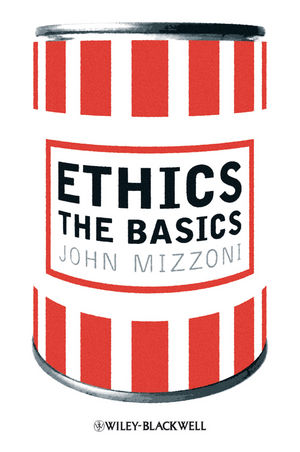Ethics: The BasicsISBN: 978-1-4051-8994-1
Hardcover
232 pages
September 2009, Wiley-Blackwell
 This title is out-of-print and not currently available for purchase from this site.
Other Available Formats: Paperback
|
1 Relative Ethics or Universal Ethics?
1.1 Relative Ethics.
1.2 Universal Ethics.
1.3 Cultural Relativism or Ethical Relativism?
1.4 Cultural Relativism and Universal Ethics.
1.5 Ethics and Human Nature.
1.6 Ethics and Human Rationality.
1.7 Relative Ethics or Universal Ethics?
1.8 Conclusion.
Concepts, Theories, and Traditions Introduced in Chapter 1.
Review Questions.
Discussion Questions.
2 Virtue Ethics.
2.1 What Are Virtues?
2.2 Aristotle, Happiness, and the Virtues.
2.3 A Developmental Model.
2.4 Universalism and Relativism Again.
2.5 Virtue Ethics: a Guide to Good Behavior.
2.6 Pros and Cons of Virtue Ethics.
2.7 Conclusion.
Concepts, Principles, Theories, and Traditions Introduced in Chapter 2.
Concepts, Theories, and Traditions Reviewed in Chapter 2.
Review Questions.
Discussion Questions.
3 Natural Law Ethics.
3.1 What Is Natural Law and Where Does It Come From?
3.2 The Natural Law and Universal Ethics.
3.3 Natural Law Ethics and Human Nature.
3.4 Natural Law Ethics and Virtue Ethics.
3.5 When Following the Natural Law is Unclear: Use the Pauline Principle.
3.6 When Following the Natural Law is Unclear: Use the Principle of Double Effect.
3.7 Conclusion.
Concepts, Principles, Theories, and Traditions Introduced in Chapter 3.
Concepts, Theories, and Traditions Reviewed in Chapter 3.
Review Questions.
Discussion Questions.
4 Social Contract Ethics.
4.1 Continuities and Discontinuities with Natural Law Ethics.
4.2 The Principle of Self-Interest (Ethical Egoism).
4.3 The State of Nature.
4.4 A Contract Involves Cooperation.
4.5 A Contract Involves Rationality.
4.6 Common-sense Morality (Properly Understood).
4.7 Social Contract Ethics Applied.
4.8 Conclusion.
Concepts, Principles, Theories, and Traditions Introduced in Chapter 4.
Concepts, Principles, Theories, and Traditions Reviewed in Chapter 4.
Review Questions.
Discussion Questions.
5 Utilitarian Ethics.
5.1 Ethics Is Based on Feelings.
5.2 Is Ought: Shorthand for Hume’s Theory of Moral Sentiments.
5.3 Feelings, Utility, and Consequences.
5.4 Utility and Happiness.
5.5 Utilitarianism: Relativist or Universalist?
5.6 Utility and Equality.
5.7 Utilitarian Applications.
5.8 Conclusion.
Concepts, Principles, Theories, and Traditions Introduced in Chapter 5.
Concepts, Principles, Theories, and Traditions Reviewed in Chapter 5.
Review Questions.
Discussion Questions.
6 Deontological Ethics.
6.1 Duty-centered Ethics.
6.2 Ethics of Freedom and Rationality.
6.3 The Main Deontological Principle: The Categorical Imperative.
6.4 One Form of the Categorical Imperative: The Principle of Autonomy.
6.5 Another Form of the Categorical Imperative: The Principle of Universality.
6.6 Duties Correlate with Rights (Usually).
6.7 Deontology: Relativist or Universalist?
6.8 Deontological Applications.
6.9 Conclusion.
Concepts, Principles, Theories, and Traditions Introduced in Chapter 6.
Concepts, Principles, Theories, and Traditions Reviewed in Chapter 6.
Review Questions.
Discussion Questions.
7 Care Ethics.
7.1 Ethics Is Based on Feelings.
7.2 Humans Are Relational Beings.
7.3 Ethics of Principles.
7.4 Virtue Ethics and Partiality.
7.5 Feminine Ethics.
7.6 Care Ethics: Relativist or Universalist?
7.7 Care Ethics Applications.
7.8 Conclusion.
Concepts, Principles, Theories, and Traditions Introduced in Chapter 7
Concepts, Principles, Theories, and Traditions Reviewed in Chapter 7.
Review Questions.
Discussion Questions.
8 Conclusion: Using the Tools of Ethics.
8.1 Living Ethical Concepts, Principles, Theories, and Traditions.
8.2 Ethical Issues, Both Private and Public.
8.3 Useful Ethical Concepts, Principles, Theories, and Traditions.
8.4 Ethical Tools Are Not Mechanical Tools.
8.5 How to Use Ethical Tools.
8.6 Pitfalls and Practice.
8.7 Wrap Up.
Review Questions.
Discussion Questions.
Appendix 1: Ethical Concepts, Principles, Theories, and Traditions.
Appendix 2: Ethical Principles.
Appendix 3: Suggested Readings.
Appendix 4: Metaethics.
Appendix 5: Select Bibliography.
Appendix 6: Glossary.
Index.



